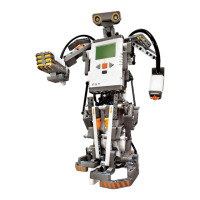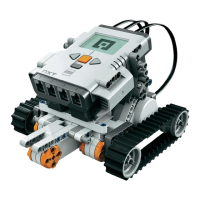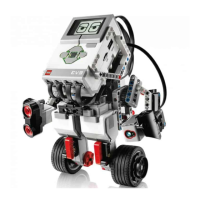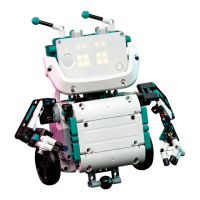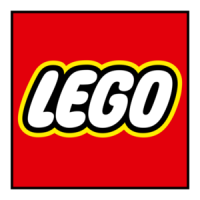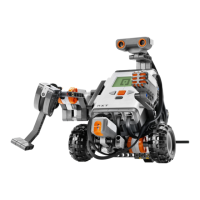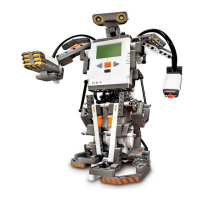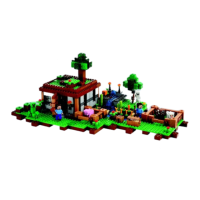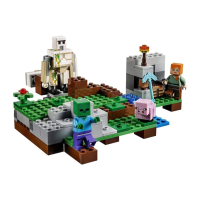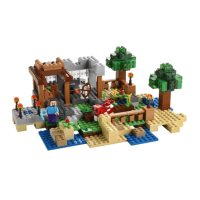
Do you have a question about the LEGO MindStorms NXT and is the answer not in the manual?
| Processor | 32-bit ARM7 microcontroller |
|---|---|
| Clock Speed | 48 MHz |
| Memory | 256 KB Flash, 64 KB RAM |
| Display | 100x64 pixel LCD |
| Power | 6 AA batteries or rechargeable battery pack |
| Sensors | Touch, Light, Sound, Ultrasonic |
| Motors | 3 Interactive Servo Motors |
| Connectivity | Bluetooth, USB |
| Programming | NXT-G |
| Input Ports | 4 sensor ports |
| Output Ports | 3 motor ports |
Introductory overview of the LEGO MINDSTORMS Education program and its benefits.
Highlights of advanced technology and available support resources.
Guidance on how to begin using the User Guide and NXT materials.
Explains the fundamental workflow of building, programming, and testing robots.
Guidance for users preferring to start programming without a computer.
Overview of core NXT components including the brick, sensors, and their functions.
Instructions for connecting sensors to the NXT input ports.
Details on using Lamps for visual effects and Converter Cables for connections.
Explanation of interactive motors for precise robot movement control.
Information on powering the NXT and connecting motors/lamps.
Step-by-step instructions for installing the rechargeable battery.
Detailed information on charging and using the rechargeable battery.
Information on alternative battery types, low battery indication, and usage warnings.
Instructions for connecting motors and sensors to the NXT.
Explanation of transferring data between computer and NXT via USB or Bluetooth.
Step-by-step guide for connecting NXT to a Macintosh computer using a USB cable.
Detailed explanation of the NXT brick's interface, ports, and status icons.
Information on using the power plug for charging or external power.
Explanation of NXT display indicators, navigation buttons, and input ports.
Instructions on how to properly turn off the NXT device.
How to name the NXT and a mention of other display features.
Detailed technical specifications of the NXT brick's hardware.
Overview of the NXT's main menu and its file subfolders.
How to create programs directly on the NXT without a computer.
Steps for selecting program options like Forward, Touch, and Backward.
Further steps for navigating NXT programs, including Touch, Loop, and Run.
Using the 'Try Me' feature to experiment with sensors and motors.
Advice on using default port settings and exploring 'Try Me' programs.
Using the 'View' menu to test sensors and motors and see their readings.
Instructions for selecting devices and ports to view readings.
Overview of the 'Settings' menu for adjusting NXT parameters.
Configuration options for sleep mode timers and speaker volume.
Procedure for deleting programs from the NXT's memory.
Introduction to the Bluetooth submenu for wireless connections.
Diagrams illustrating the structure of My Files and NXT Program menus.
Diagrams showing navigation options within View, Bluetooth, Settings, and Try Me menus.
Explanation of the touch sensor's operation, states, and usage suggestions.
How to test and view the touch sensor's response on the NXT display.
Examples of 'Try Me' programs demonstrating touch sensor interactions.
Guidance on creating programs using the touch sensor directly on the NXT.
Explanation of the sound sensor's operation, measurement, and usage ideas.
How to test and view sound sensor readings on the NXT display.
Examples of 'Try Me' programs demonstrating sound sensor interactions.
Guidance on creating programs using the sound sensor directly on the NXT.
Explanation of the light sensor's operation, capabilities, and usage ideas.
How to test and view light sensor readings on the NXT display.
Specific instructions for viewing reflected light and color detection.
Testing ambient light levels using the light sensor.
Examples of 'Try Me' programs demonstrating light sensor interactions.
Guidance on creating programs using the light sensor directly on the NXT.
Explanation of the ultrasonic sensor's operation, measurement, and usage ideas.
How to test and view ultrasonic sensor distance readings on the NXT display.
Examples of 'Try Me' programs demonstrating ultrasonic sensor interactions.
Guidance on creating programs using the ultrasonic sensor directly on the NXT.
Explanation of interactive motor operation, built-in sensor, and usage ideas.
Details on the motor's built-in rotation sensor for precise control.
How to test and view motor rotation readings on the NXT display.
Examples of 'Try Me' programs for interactive motors and sounds.
Guidance on creating programs using interactive motors directly on the NXT.
Explanation of the functionality and uses of the NXT lamps.
Instructions on using lamps to activate the light sensor.
Overview of Bluetooth technology for wireless communication with the NXT.
Explanation of what Bluetooth enables, such as wireless data transfer.
Requirements and checks needed before establishing a Bluetooth connection.
Step-by-step guide for connecting the NXT to a PC using Bluetooth.
Process of scanning for, selecting, and connecting to Bluetooth devices.
Explanation of using passkeys for secure Bluetooth connections.
How to confirm the Bluetooth connection using the passkey on the NXT.
Viewing and understanding the NXT's connection status within the software.
Step-by-step guide for connecting the NXT to a Macintosh using Bluetooth.
Procedure for scanning and connecting Bluetooth devices on a Macintosh.
Instructions on how to pair Bluetooth devices with the NXT.
Managing passkeys for pairing and confirming connections.
Exploring options within the NXT's Bluetooth submenu.
Managing lists of previously connected devices and current connections.
Viewing connection status and managing NXT settings via the software window.
Options for controlling NXT Bluetooth visibility and turning the function on/off.
Step-by-step guide for connecting multiple NXT devices via Bluetooth.
Instructions on how to transfer programs between NXT devices.
Information on connecting multiple NXTs or devices at the same time.
Instructions for connecting the NXT to a mobile phone via Bluetooth.
Introduction to the LEGO MINDSTORMS Education NXT software.
Specifies hardware and software requirements for installing the NXT software.
Step-by-step instructions for installing the software on Windows systems.
Step-by-step instructions for installing the software on Macintosh systems.
Guide to creating a simple program to make the NXT play a sound.
Instructions on how to launch the software and name new programs.
Guidance on selecting the Sound block from the programming palette.
Steps for adding blocks and downloading the program to the NXT.
Instructions on how to download and run the completed first program.
An overview of the main components of the software's graphical user interface.
Detailed explanations of each numbered component of the software interface.
Introduction to the Robot Educator tutorials for programming.
Guidance on viewing and opening programming examples in the Robot Educator.
Instructions for building the physical Robot Educator model.
Guidance on programming the Robot Educator model using the workspace.
Information about program examples available in the Common palette.
Examples showing how to use icons from the Complete palette.
How to find examples for specific NXT technologies.
Instructions for accessing My Portal for software information and updates.
Introduction to the programming palettes containing all necessary blocks.
Instructions on how to download created programs to the NXT.
Detailed explanation of blocks available in the Common palette.
Explanation of the Move block for controlling motors and lamps.
Explanation of the Record/Play block for physical movement programming.
Explanation of the Wait block for sensor input or time intervals.
Explanation of the Sound block for generating sounds.
Explanation of the Loop block for repeating program actions.
Explanation of the Display block for controlling the NXT screen.
Explanation of the Switch block for implementing decision-making.
Overview of block categories in the Complete palette: Action, Sensor, Flow.
Blocks that control specific types of behavior related to output devices.
Blocks used in combination with sensors to control robot behaviors.
Blocks for creating complex behaviors, logic, and decision-making.
Explanation of Data blocks and Advanced blocks for programming.
Using Custom Palette and Web Downloads for reusable and downloaded programs.
How to adjust settings for selected programming blocks.
Explanation of the software controller buttons for NXT interaction.
Comprehensive list of all building elements included in the LEGO MINDSTORMS Education NXT Base Set #9797.
Continuation of the parts list for Base Set #9797, detailing various beams and connectors.
Continuation of the parts list, including axles, motors, sensors, cables, and battery.
Functionality for downloading one or more programs to multiple NXTs simultaneously.
Ensuring programs are open and NXTs are available before downloading.
How to access the 'Download to Multiple NXTs' dialog box from the Tools menu.
Troubleshooting tips and explanations of download status and progress options.
General section for addressing common issues with the NXT.
Steps to reset the NXT if it freezes or becomes unresponsive.
Instructions for updating the NXT firmware from a computer.
How to manage and delete files from NXT memory to free up space.
FCC compliance details for US/Canada and EU directive compliance for UK.
